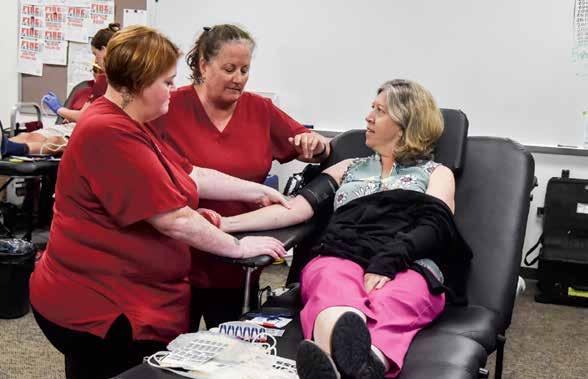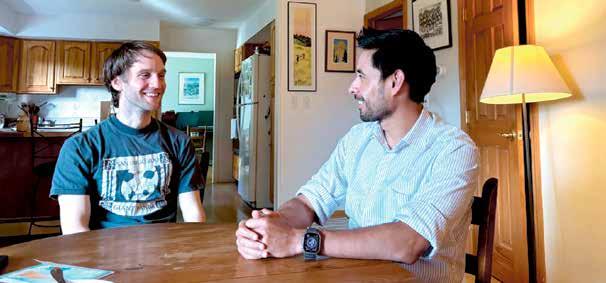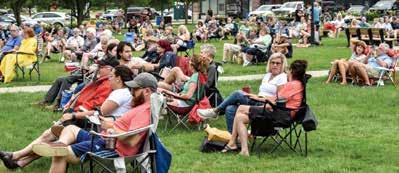A little bit of yourself… a miracle for others


A little bit of yourself… a miracle for others

BY TRENT SNYDER Special to the Observer
A spreadsheet cataloging military-affiliated burials across Chittenden, East, Morse and Deerview cemeteries is now available to the community thanks to the Eagle Scout project of Corey Caulfield.
Caulfield has been a part of Williston’s Scout Troop 692 since kindergarten, going through Cub Scouts, Boy Scouts and now on his way to becoming an Eagle Scout — the highest honor in scouting.
“I’m all about the community,” Caufield said when asked why he wanted to be an Eagle Scout. “That’s why I do it.”
Using photographs of gravesites submitted by volunteers to the website billiongraves.com, Caulfield consolidated local data into a

comprehensive spreadsheet that can be accessed at billiongraves.com and on the Town of Williston website (town.williston.vt.us). A physical version of the spreadsheet has
or conflict the individuals served in.
In order to become an Eagle Scout, a Boy Scout has to complete an Eagle Scout project, collect the necessary merit badges, and

Scout Corey Caulfield presents his researched spreadsheet — posted at East Cemetery — of military-affiliated burials in Williston.
also been posted at East Cemetery. It provides a list of first and last names, grave location, and the war
be an active member of a troop. Most Eagle Scout projects are

BY JASON STARR Observer staff
It’s not like we weren’t warned.
The Vermont Agency of Transportation’s weekly update on construction progress at the Industrial Avenue-Route 2A-Mountain View Road intersection routinely contains the bolded and underlined note: “Motorists should expect significant daytime delays.” Signs in the vicinity of the project urge people to seek alternate routes between Essex Junction and Williston.
But there is no alternate route to get to the homes and businesses in the roughly mile-long project area along Route 2A. Clients
getting to appointments at River Cove Animal Hospital, for example, have no choice but to brave the bottleneck.
“We’ve had a lot of people late for appointments,” said Jessica Rowe, who works the front desk at River Cove. “We’ve also had people misjudge it and get here like 20 minutes early because the last time it took an extra 20 minutes sitting in traffic.”
The project involves a reconstruction of the intersection at Industrial Avenue with new turning lanes and a new traffic light; new pavement markings, signage and street lighting; widening of Route 2A to create a center turning lane; and new stormwater retention infrastructure. Lane closures with alternating oneway traffic controlled by flaggers occur between 9 a.m. and 3




Green Mountain Habitat for Humanity on Monday announced that David Mullin, who has served as executive director and more recently as CEO of the organization for over 25 years, will retire in February.




Under his leadership, the Williston-based organization has increased the number of homes built and families served each year, with over 121 local families now living in homes built by Green Mountain Habitat for Humanity.
An affiliate of Habitat for Humanity International — a global nonprofit housing organization that has helped more than 46 million people construct, rehabilitate or preserve homes since 1976 the organization expanded its home building service area to include Franklin, and Lamoille counties under Mullin.

“David has been instrumental in advancing our homeownership mission of partnering with
The Richmond Historical Society is hosting two live concerts in August at the Old Round Church, a national historic landmark.
On Aug. 2, Twangtown Paramours will come to town, bringing their soulful Americana music from Nashville, Tenn. The show starts at 7 p.m.

families and other housing organizations in the community to build permanently affordable, energy efficient homes for families in need,” said Ted Johnson, president of the nonprofit’s board of directors. “His dedication to affordable housing and his commitment to our community have left an indelible mark on countless families throughout Vermont.”
During his tenure, David has also overseen the launch of
Habitat for Humanity ReStores, in Williston, Milton and Swanton.
“It has been the honor of my career to work alongside our incredible volunteers, staff, partner families and supporters,” said Mullin. “Together, we have transformed lives. While I will miss this work deeply, I am confident that Green Mountain Habitat for Humanity will continue to thrive and serve our community for years to come.”
The board of directors has established a search committee to identify and recruit the next leader. The committee will conduct a national search.
“We are committed to finding a leader who will build upon the strong foundation David has established,” Johnson said. “Our search will focus on identifying someone with proven nonprofit leadership experience, a passion for affordable housing, and the ability to engage our diverse community of supporters.”
For more information, visit vermonthabitat.org.
On Aug.12, the Vermont based bluegrass, folk and Americana group Otter Creek will play a 7 p.m. show.












The shows are sponsored by Northfield Bank, and all proceeds benefit the preservation of the Old Round Church as well as the projects of the Richmond Historical Society.
Admission by donation is suggested at $15.
For more information on the performers, visit www.

thetwangtownparamours.com and www.ottercreekband.com.
For more information on the Richmond Historical Society, visit www.richmondvthistory.org.
A story published in the July 17 edition of the Observer headlined “Longstanding mechanical contractor opens Williston manufacturing shop” mistakenly reported that John W. Danforth Company has worked with Ben & Jerry’s ice cream. The story should have said that Danforth has worked with Barry Callebaut chocolate.
Friday, August 1, 2025, 10am - 4pm
Champlain Valley Expo, Essex Jct, VT
10AM - 11:45AM | SUMMIT
12PM - 4PM | 100+ RESOURCE BOOTHS, BREAK-OUT ROOMS, RECOVERY PROGRAM,
THERE IS HOPE. I CAN’T, BUT WE CAN. Over the last few years, we have seen progress on substance use addiction awareness and identifying valuable resources for help and change. We also know that there is a lot of work to do. This event is open to the public. We urge anyone who is interested in knowing where resources are for themselves or someone they love, who is battling addiction, to attend. It is about hope for anyone struggling with substance use, making more resources available statewide and saving lives.
• Increase Residential and Recovery Beds: Addressing the urgent need for more residential and recovery residence beds in Vermont.
• Extend Residential Stays: Advocating for longer residential stays and increased Medicaid reimbursements to support these beds.
• Tri-State Treatment Model: Proposing a collaborative treatment/ recovery model for Maine, New Hampshire, and Vermont.
• Longer Recovery Model: Highlighting comprehensive programs like Jenna’s Promise that include workforce development.
• Humanizing Addiction: Emphasizing the distinction between addiction and the individual, recognizing their humanity.
• Support for Law Enforcement: Integrating recovery and mental health workers with law enforcement efforts.
• Political Attention: Drawing more political focus to substance use addiction.






Williston firefighters responded to a fire at a home on White Birch Lane early Wednesday morning. One resident of the home evacuated safely, and no injuries were reported.
Firefighters from neighboring towns also responded to the scene about 1 a.m. The fire was controlled within 30 minutes, according to Williston Fire Lt. Anthony Simanskas.
“Upon arrival, our focus was
on implementing a strategic and aggressive fire attack to contain the fire quickly while ensuring the scene was secured for the safety of both residents and first responders,” Simanskas said in a news release. “The seamless collaboration between our department and mutual aid teams was instrumental in controlling the situation efficiently.”
The cause of the fire remains under investigation.
continued from page 1
p.m. The traffic light at Industrial Avenue is occasionally turned off during this time.
“We’re doing our best to manage traffic appropriately,” said the Vermont Agency of Transportation’s Northwest Regional Construction Engineer, Kara Yelinek. “It’s a very high volume intersection so there is just a lot of traffic to manage, especially during some of the busier times of day.”
ECI Construciton, headquartered in Williston, is the state contractor working on the project. ECI subcontracts with ADA Traffic Control of Colchester and Green Mountain Flagging of Williston to manage the traffic.
Backups on the southbound side of Route 2A have typically been longer than the northbound side. A bumper-to-bumper line of cars has frequently been backed up from the intersection into Essex Junction at the Winooski River bridge. Drivers occasionally opt for an illegal U-turn back toward Five Corners instead of


“We’re doing our best to manage traffic appropriately. It’s a very high volume intersection so there is just a lot of traffic to manage, especially during some of the busier times of day.”
Kara
Yelinek Vermont Agency of Transportation
submitting to an unknown delay.
Yelinek said there is no way for flaggers to know in real time how far the traffic is backed up on either side and manage the flow accordingly. They rely on a “general understanding” of which directions tend to see heavier traffic at certain times.
“We try to prioritize it as best we can,” she said.
But for David Mullin, the extent of the delays has seemed
extraordinary. Mullin is the CEO of Green Mountain Habitat for Humanity, which operates its Williston ReStore in the project zone on Route 2A. ReStore takes donations of furniture, appliances, clothing and other items and sells them to fund the non-profit’s affordable home-building program.
He said donors are avoiding drop-offs and sales are down about 40 percent.
“People are going all the way to (the) Milton (ReStore) to make donations. They say ‘there’s no way we’re going to Williston with the traffic the way it is,’” said Mullin.
Mullin believes the traffic backups can be better managed to reduce delays.
“I’ve never, in all my driving, run into a construction situation where you’re waiting 30 minutes in a line to move half a mile,” he said. “That just seems like poor planning. It’s not the most unique construction project ever.”
“Forethought to how the traffic is going to move through there obviously hasn’t gone on.”
The project is slated for completion in the fall of 2026.

























personal and communal benefits of biking and walking
BY KEVIN BATSON Williston Energy Committee
“A person on foot, on horseback, or on a bicycle will see more, feel more and enjoy more in one mile than the motorized tourist will in a hundred.”
This quote by Edward Abbey is very true here in Vermont, where we have many paths, trails and backroads to explore for recreation, exercise, running errands or commuting to and from work.
Williston’s Catamount Outdoor Family Center and the nearby towns of Burlington and South Burlington have miles of off-road trails and bike paths perfect for a fun family outing, or just some exercise and fresh air. Soon it will be possible to ride from the Route 2A Essex Junction bridge to Allen Brook and Williston Central Schools mostly on a bike path, when the Route 2A/Industrial Avenue project is completed and the new pedestrian bridge over the Allen Brook








BY CAMRYN WOODS Community News Service
Vermont’s single landfill in Coventry receives hundreds of thousands of pounds of waste every year. Most of that amount is municipal waste — regular household and business trash like a Snicker’s wrapper or an old rocking chair.
A report by the Vermont Department of Environmental Conservation showed that, in 2023 alone, Vermonters generated 540,000 tons of municipal solid waste.
Vermont’s solid waste plan has a goal to prevent 50 percent of the state’s waste stream from entering the landfill by reducing, recycling, repairing and composting. The closest the state has come to meeting that number was in 2024, when 41 percent was diverted, according to Josh Kelly, solid waste program manager of the Waste Management and Prevention Division at DEC.
In order to reach state goals, and connect Vermonters across the state, DEC created a new initiative called ReVT to be administered by Anne Bijur of the Solid Waste Division.
The goals of the initiative are twofold, said Bijur, who supervises the materials management section of the division.
“The first is to build this coalition around waste reduction, reuse and repair,” Bijur said. “The second is to create an open, inclusive
network that supports practitioners and all Vermonters to participate.”
ReVT held its inaugural board meeting on May 13 over Microsoft Teams. The meeting was open to anyone interested in reuse and repair opportunities.
Forty-five participants logged on to learn from the program’s advisory committee and presenters. At the end, they were given the opportunity to engage in a 20-minute breakout group session to provide their feedback.
Presenters at the meeting included a Front Porch Forum representative, the owner of a secondhand craft store in Burlington and an organizer of repair cafes in Addison County.
Susan Alexander, the program coordinator of ReVT, recognized the broad community that the initiative involved. It was this diversity, she said at the meeting, that would make ReVT a success.
“There are a lot of different angles to this,” Alexander said in a later phone call. “There are the people who are trying to make a living doing it. There are the folks who are trying to preserve our planet and conserve resources. There are people who love fixing things. There are people who love going to thrift shops.”
Through ReVT, Alexander hopes to amplify opportunities for reducing, reusing and repairing, cutting down on the amount of waste going to the Coventry landfill.
These processes also conserve the natural resources used to make these products, Alexander said.
The program can also support a circular economy, Alexander said, where goods are recycled indefinitely, moving through many hands rather than ending up in the trash after the first use.
“(We’re) going to keep things looping through their life cycle as many times as possible.”
Susan Alexander ReVT Program Coordinator
“Instead of buying something at the store, then it breaks and goes to the landfill,” Alexander said, “(ReVT) is going to keep things looping through their life cycle as many times as possible.”
The project is funded through a Solid Waste Infrastructure for Recycling grant provided by the Environmental Protection Agency in 2023. Of that grant, almost $17,000 was allocated to ReVT’s initiatives. Though the money is guaranteed now, it is unclear whether further funding will be provided after the conclusion of the contract in August 2026, Kelly said.
Regardless of funds, Kelly, Bijur and Alexander hope that ReVT will become a movement with a lasting impact. Their ultimate goal is to build support toward a coalition similar to the Composting Association of Vermont, which hosts a conference every spring.
“Often there are local solutions that can contribute to an economy,” Kelly said. “I just think people need that awareness to think about reuse and repair first — not only for reducing waste, but for the people that it sustains.”
Arianna Soloway, who presented at the ReVT meeting, is one of those people. She started a secondhand art store and community art space last November. Her store, The Makery, is located on 388 Pine St. in Burlington.
Soloway said that she was inspired to start The Makery from her job as the manager of Muscle Up Yarn in Shelburne, where customers would come in asking for places to distribute unused materials from late family members. Others would come in looking for more affordable crafting supplies.
After doing some research, Soloway was surprised to find that Burlington didn’t have a secondhand art store — and decided that she could change that.
“There was a point in my head I think where it went from, ‘I wish somebody else would do that,’ to, ‘What if somebody else does that
before I do?’” Soloway said.
The Makery also provides ways for longtime artisans and prospective artists alike to bond over low-pressure crafter gatherings.
“It’s so hard as an adult to try something new and to feel like, ‘Is this worth it?’” Soloway said. That’s why her “Craft and Sip” nights were born, along with other workshops.
Looking forward, ReVT plans to host more community meetings to provide space for discussion and feedback. It is also committed to increasing the prominence of events like repair cafes and the visibility of local handypersons through statewide directories.
“We want (ReVT) to be driven by the community,” Alexander said. “We don’t want to tell them, ‘This is what we’re going to show you.’ We want people in that reuse and repair community to come to us and say, ‘Hey, we’d like to learn about this.’”
ReVT’s email newsletter currently reaches about 150 people. Members have access to the program’s newsletter, which highlights reuse and repair businesses, recaps previous meetings and provides space for individuals to voice their thoughts.
“I think more than anything, I’m just glad to be a part of the solution,” Soloway said.
Community News Service is a University of Vermont journalism internship.


is connected through the Annex development.
Trails and paths create a third space where walkers, rollers, runners and bikers can get out in the community and see and connect with others without spending money. Stopping to pet a dog, offering a greeting or chat with an acquaintance, are all important to prevent loneliness, which is a physical and mental health concern.
Loneliness’ health impact is said to be like smoking 15 cigarettes a day. Beyond increasing the risk of anxiety and depression, social isolation and loneliness can increase the risk of heart disease by 29 percent, stroke by 32 percent and dementia by 50 percent. Poor social connection can increase risk of premature death by more than 60 percent (see “Our Epidemic of Loneliness and Isolation” at hhs.gov).
Getting out on paths and trails is as simple as it gets and is always rewarding. Whether for recreation or transportation, there are many other benefits to be gained. We hear all the time about the health benefits of exercise: cardiovascular, agility,

muscle and bone strength, weight management, stress reduction and mood improvement. These health benefits are enhanced with moderate or vigorous exercise — by picking up your pace or adding hills.
Pedal assist electric bikes are becoming more popular and can help make biking Vermont’s hills easier and more enjoyable. They can also make commuting easier and less sweaty yet still provide moderate or vigorous physical activity. They are also helpful to allow one to keep pace when riding with those who may be stronger riders. Unless there is good reason, youth should be encouraged to use non-electric bikes.
Gauging by the number of student bikes parked outside our schools, Williston parents are doing a great job. When students walk or bike to school, studies have shown them to be more attentive and better prepared for learning. And even more beneficial, they learn the lifelong lesson of an active lifestyle, they gain motor-skills, self-confidence, independence and get to know their risk boundaries — all attributes needed for developing maturity.
Safe Routes to School, a program of the U.S. Department of Transportation that is supported by our town, schools and Local Motion,
has a goal of encouraging more riding, walking and rolling to school. One day every month during the school year, a dedicated group of parents and volunteers lead walkand-rolls to Williston Central School and Allen Brook School. During the 2024-2025 school year, about 450 students walked or rolled on the adult-led routes. Bike camps like those at Catamount Outdoor Family Center and commuting to school are excellent tools for building stronger, more resilient youth.
Stronger, more resilient youth can result in stronger adults. On a recent hot July Sunday, I rode with 12 riders on the hilliest Green Mountain Bike Club touring group ride in the Adirondacks. We had riders in their 20s and some in their 80s. We finished our almost 50-mile ride in four hours, taking a leisurely long food/ social break midway and stopping at every significant turn to regroup. To see the vigorous older riders on non-electric bikes doing as well as anyone was inspirational and food for thought. The GMBC also has a Social Touring Group which does shorter, slower rides. (thegmbc.org) It is often desirable or necessary to travel on foot or bike where there are no trails or paths. To keep safe, cyclists and pedestrians must obey

the rules of the road. As of July 2024, with the passage of new legislation, motorists are required to slow down and leave 4 feet of clearance when passing a cyclist or pedestrian (23 V.S.A. § 1033). “Williston on the Move” (WOTM), Williston’s bike/pedestrian advocacy group, is starting a campaign to improve awareness of this new state passing requirement law.
Additionally, WOTM has recently had some success working with the town to improve wayfinding signage on pedestrian/bike routes through lighter trafficked streets in town and on connecting gaps in our path system. There is much more that can be done to improve non-motorized
connectivity around Williston. If you are interested in getting involved, consider being part of WOTM by emailing kevbvt@gmail.com, and let your town officials know that safe pathways for pedestrians and cyclists are important to you.
To participate in Williston’s energy future, reach out to your Williston Energy Committee at energy@willistonvt.org or attend a public meeting held on the second and fourth Wednesday of each month. The agenda for upcoming meetings is posted on the Town of Williston website (www. town.williston.vt.us). For more information, visit: https://www. willistonvtenergycommittee.org.






BY BILL SCHUBART
New York City, the largest city in the United States, with a population of 8.4 million people — or 2.5 percent of the country — has chosen a young progressive democrat, Zohran Mamdani, in a landslide as their lead Democratic candidate for mayor. The Democratic Party elite, despite being in popular decline, has decided to line up against him.
Raise foot, load pistol, aim at foot, pull trigger.
I’m sorry, in this time of partisan chaos and an accelerating wealth gap, the noncommittal center will not hold. A growing percentage of this country is simply unable to make ends meet and are desperately casting about for a way forward that will fulfill the promise of their country: economic security, due process, freedom to speak their minds and to elect people they feel represent them in getting that job done.
Some Americans will still cling to their narrow ideologies
on the right or left, but most of us watch with fear what’s going on nationally and want to work for a reunification that celebrates and strengthens us all, starting with economic security.
We rattle on about MAGA Republicans who don’t have the courage to stand up for their constituents against Trump and his camouflage cabinet of tech-elite billionaires. But it’s time now to call out our own nervous-nellie, “centrist” Democrats like Chuck Schumer, Hakeem Jeffries and the others who deter or outright refuse to support Mamdani. They, too, are funded by techelite interests.
We must remind them that, since FDR, the strength of the Democratic Party has been that it stood for the common good rather than the further enrichment of elites. In FDR’s time, the elites were monopolist industrialists. Today it’s the techelite — Peter Thiel, Elon Musk, Mark Zuckerberg, Jeff Bezos, Larry Ellison, et. al. — who pay homage to “democratic values” but, in reality, believe they can
manage our lives better than we can and should manage them for us.
So much for the common good.
Some of the old-line Democrats have gone so far as to endorse Eric Adams, the disgraced current mayor of New York City who has announced he is running again in November, even though he is under federal indictment for conspiracy to defraud the United States: one count of wire fraud; two counts of soliciting campaign contributions from foreign nationals; and one count of soliciting and accepting a bribe. Is this what the Democratic Party has become?
My only wish is that Mamdani had called himself a “democratic socialist.” “Socialist” has no real meaning in today’s society and is easily used by opponents to tag him as some Marxist
politician. I understand what he’s saying, and he clarified it himself on Fox News: “To me, it means that every New Yorker has what they need to live a dignified life. It’s local government’s responsibility to provide that,” he said.
He would achieve this with a rent freeze on the city’s 2.3 million apartments, free childcare starting at six months, free buses, and a $30/hour minimum wage by 2030 ($30/hour is the current calculation for a livable wage for New Yorkers).
The federal minimum wage in the United States in 2025 remains $7.25 per hour. Who in the country, much less New York City, can live on $15,000 a year?
My problem with the term “socialist” is that it is now most often used derogatorily, at least in this country where it has, for


P.O. Box 1401, Williston, VT 05495 | 802-489-5499
ADVERTISING
Rick Cote, Associate Publisher rick@willistonobserver.com 802-373-2136
EDITOR
Jason Starr editor@willistonobserver.com
PRODUCTION & DESIGN
Jan Kenney
jan@willistonobserver.com
PUBLISHER
Susan T. Cote susan@willistonobserver.com
BILLING INQUIRIES
Michael McCaffrey office@willistonobserver.com
ADVERTISING SPACE DEADLINE Friday at 5 p.m. for the next Thursday issue rick@willistonobserver.com, 802-373-2136
CLASSIFIED ADS
Deadline is Friday 5 p.m. There is a fee for business, real estate, help wanted and legal ads. Free classifieds must be 25 words or fewer and are printed on a space available basis.
SUBMISSIONS & LETTERS Deadline is Monday noon for Thursday issue. News/ story tips are welcomed. Letters to the Editor should be 300 words or fewer and include your name, address and a daytime phone number so that we can verify the letter’s author.
many years, been synonymous with communism. Whereas its spectrum of vernacular meaning includes a description of the popular Scandinavian economies, wherein high taxes are used cost-efficiently to fund a social safety net. A majority of Scandinavians have, in other words, a shared belief in funding the common good.
“Socialism” is already being used widely here in political broadsides against Mamdani, with the clear intent of associating him with past figures like Marx, Engels and Trotsky rather than many progressive economies that now exist around the world.
What will put this country on a better footing? Not the tech-elites, who will use their vast wealth and influence to fight any form of progressive see SCHUBART page 9


taxation of their wealth or effective regulation of their businesses. Mamdani, by contrast, has suggested a 2 percent tax on the top 1 percent of New Yorkers making more than $1 million a year. To put this in perspective, currently just 34,000 households (or 1 percent) account for 35 percent of all earnings in the Big Apple.
He has also proposed raising the top corporate tax rate to match neighboring New Jersey’s at 11.5 percent. These two reforms in NYC would alone bring in $10 billion, funds that could be used to invest in a social safety net for poorer New Yorkers.
The other attack strategy being used against Mamdani is to accuse him of “antisemitism.”
In the recent primary campaign for mayor, former New York Governor Andrew Cuomo did not shrink from attacking him as an “antisemite” and even “a Holocaust denier.” Since Cuomo was roundly defeated by New Yorkers, Republicans are trying
to paint Mamdani as the poster child of a Marxist, terrorist immigrant. And some Democratic politicians are joining forces with them, as I’ve noted.
New York’s business leaders and Wall Street elites are in a swivet about Mamdani’s rise, and it remains to be seen how they will respond.
Meanwhile, President Trump has broached the subject of stripping Mamdani of his U.S. citizenship after Andy Ogles, a Republican from Tennessee calling him “little Muhammad,” demanded his citizenship be revoked, claiming with no evidence that Mamdani concealed his support for “terrorism during the naturalization process.”
Admirably, Sen. Chris Murphy, a Connecticut Democrat, recently wrote on his Bluesky account, “Trump will stop at nothing to protect billionaires and price gouging corporations … Zohran won because he ran a campaign laser focused on putting power back in the hands of working people. And that’s a threat to the Mar a
Lago crowd.”
Quite simply, the way forward for this seemingly lost Democratic Party is to listen to its constituents. Since the Obama era, the party has been in popular decline, in large part because it seems they are trying to play both sides of the interests that support them … voters and megadonors. There comes a time in our lives when we must choose. History has proven that we cannot be all things to all people, as the Preamble to our Constitution says:
“We the People of the United States, in Order to form a more perfect Union, establish Justice, insure domestic Tranquility, provide for the common defence, promote the general Welfare, and secure the Blessings of Liberty to ourselves and our Posterity, do ordain and establish this Constitution for the United States of America.”
Bill Schubart of Hinesburg is a writer, retired businessman and former chair of the Vermont Journalism Trust, the parent organization for VTDigger.



The Friends of the Library annual book sale raised $8,230. Thanks to everyone who donated and everyone who came and shopped.
A special thank you to Boy Scout Troop No. 692, which did a lot of working setting up the sale. And thanks to the many people who sorted books into categories during June, helped with the setup, worked during the sale hours, and helped with “teardown” on the afternoon of July Fourth.
We’d also like to thank Starbucks in Williston for giving us used shipping boxes so we had uniform sizes of boxes to pack books.
People ask what we do with unsold books. During teardown, we re-box any unsold books, stack the boxes onto pallets, and wrap
the stacked pallets. These pallets get shipped to Thrift Books, a book website. We get a percentage of any of our books that they sell.
People also ask what we do with the profit. We sponsor special programs yearly for children and families, such as the holiday Gingerbread House activity and a spring family nature program. We fulfill requests for items/programs that are not part of the library budget, such as second sets of K-12 award-winning books so that the library has ample copies of these popular books, as well as audio books if they are available for these titles.
Again, thanks to everyone who supported the book sale this year! Ann Park
Friends of the Dorothy Alling Memorial Library
LETTER POLICY: We ask that letters run no longer than 300 words. We edit for length, clarity, style, spelling and grammar. Please include your name, town or city where you live and a daytime phone number (which we won’t print) so we can verify you wrote the letter. The deadline is Monday at noon for letters to be printed in Thursday’s paper. Email: editor@ willistonobserver.com or mail to Williston Observer, P.O Box 1401, Williston, Vt. 05495


Since the floods of 2023, few Vermonters have received payouts
BY CARLY BERLIN VTDigger
PEACHAM — The green clapboard house where Jenny Mackenzie lived for over two decades sits boarded up and ghostly along a narrow gravel road in the Northeast Kingdom. Late one night last July, the brook that once snaked lazily around the property frothed into a raging river, jumping course. Mackenzie’s family of four escaped before their home was inundated. They haven’t lived here since.
On a sunny morning nearly a year after the flood, Mackenzie returned with a shovel and a trunk full of empty flower pots. She was here to salvage some of her once sprawling gardens. Much of what had bloomed here had simply disappeared; the lawn had collapsed into the brook, leaving a gaping hole. Yet Mackenzie was determined. She scaled down the steep ledge above the water, hanging onto a root for balance.
“Operation rescue!” she called out, grasping for a piece of a mallow plant. “Just one little piece, but it’ll spread.”
Last summer’s flood wasn’t the first to hit the property. In 2011, Tropical Storm Irene compromised the home’s foundation. So the family poured over $100,000 into flood-proofing the house, fortifying its base, along with replacing its electric and heating systems and repairing its well. Federal disaster grants and loans helped cover some of the costs, but Mackenzie didn’t recall any officials suggesting her family apply for a buyout. She painstakingly replanted her flower gardens.
This time around, there would be no returning to the house — for the Mackenzies, or anyone else. FEMA had recently approved the family’s buyout application, meaning that some day, the government would compensate the Mackenzies for this place, and knock it down. The lot would be held as open space in perpetuity.
But as far as Mackenzie knows, that day is still far in the future — another year from now, at least. Hands covered in silt and dirt, she paused to consider the long task ahead.
“I guess I get another summer to come dig things out,” she said.

After historic flooding swept through Vermont in 2023 and 2024, hundreds of property owners applied for buyouts to try and get compensated for homes and businesses they would likely struggle to sell.
Vanishingly few have

happened yet. State officials are currently overseeing 264 FEMA buyout applications. Of those, only eight property owners have gotten their payouts so far. Zero demolitions have occurred as of mid-July 2025, according to data provided by Vermont Emergency Management.
“It feels like a very low number, two years out,” said Stephanie Smith, the state hazard mitigation officer for Vermont Emergency Management. FEMA’s buyout process is notoriously slow and arduous, requiring local, state and federal


continued from page 10
officials to all work together.
But Smith’s team, which manages federal buyout applications on behalf of Vermont cities and towns, had worked hard to speed things up, she said. Streamlining the application process on the state’s end helped cut down FEMA’s review period from a year and a half to about three months, as of this past winter, Smith said.
Soon after President Donald Trump took office, though, roadblocks started to arise. In February, applications that Smith expected FEMA to greenlight relatively quickly sat idle for months. Meanwhile, the Trump administration began reviewing the efficacy of FEMA programs; more than $100 billion in FEMA grant payments were frozen, and grant approvals stalled, according to reporting from the New York Times. (FEMA’s press office declined an interview request for this story, and did not answer detailed questions from VTDigger/Vermont Public).
This spring, FEMA started sending out approval letters again. But then came the next hurdle: It began quietly changing its rules for authorizing buyout applications, raising the bar on which projects it approves, Smith said. In early April, the agency, at the direction of the Trump administration, altered which projects it views as cost-effective, according to a mid-June press release.
“We were like … OK, here’s a giant brick wall. Deep breath, what do we do?” Smith said. “We don’t want to have to tell people that they’re not going to get buyouts. We told them they were going to get buyouts.”
Asked why the agency opted to make this change, FEMA’s press office said in a statement — attributed to an unnamed spokesperson — that hazard mitigation decisions are “policy informed.” The Trump administration is monitoring the approval of hazard mitigation funding, “with states’ ability to execute those funds,” the statement said.
“To date, we are observing large unobligated balances across the board. We are working with states to assist them in identifying projects and drawing down balances in a way that makes the nation more resilient.”
When state officials learned
of the rule change in late May — prior to its official announcement — they scrambled to rework all the applications they were getting ready to send to FEMA, along with ones currently under the agency’s review, Smith said.
Almost 100 retooled applications later, all are still in the pipeline, for now. But Smith doesn’t feel relieved. If an already-approved application were to need any kind of tweaking, it would suddenly need to comply with different rules. For people still awaiting a decision from FEMA, that lengthy undertaking has slowed down. And, given the Trump administration’s calls to eliminate FEMA and devolve its functions to states, everything seems precarious.
“It feels like we’re on the edge of a knife a little bit, and toggling … and just trying to keep everything balanced,” Smith said.
‘WE’RE
Hundreds of Vermonters are caught in that balance. Many are waiting to hear whether FEMA will advance their applications. Many others have cleared that step, but are biding their time before the money finally arrives — and navigating tricky financial decisions in the meantime.
Peter Anthony, a former state representative for Barre City, had owned his home on Scampini Square for nearly 50 years. The July 2023 flood totaled it, and more flood damage came a year later, he said. Anthony and his wife have lived in a small downtown apartment since August 2023, which FEMA rental assistance helped pay for until January.
Two years after applying, Anthony recently received indication that his buyout is finally near the finish line. He expects to sit down and sign the closing paperwork later this summer.
Yet he doesn’t expect the payout to solve his financial woes. Anthony wants to buy another home in Barre. But the appraisal he received through the buyout process — which is pegged to the home’s pre-flood value — is $175,000, Anthony said, an amount that would “maybe buy half a house” in the current market. And he isn’t getting any younger.
“How many mortgages can you get when you’re 81 years old for a house that you want to buy?” Anthony said.
To the east in Peacham,
Rachael Moragues is also waiting on buyout money. She lived next door to the Mackenzies with her two sons, and they’ve bunked up at a friend’s house in neighboring Barnet since the flooding in 2024 rendered their home uninhabitable. Each month, Moragues still makes a mortgage payment on a house she’ll never live in again.
She’s keeping an eye on the fate of FEMA. If for any reason her buyout doesn’t go through, she would need to file for bankruptcy to pay off the house, she said.
“We’re all nervous because FEMA is one of those agencies that may or may not receive funding in the future,” Moragues said.
Looking at her old, boarded-up home, Mackenzie said she worries about what Trump’s calls to cut FEMA will mean for families like hers across the country. But she knows she’s relatively fortunate.
Friends crowdsourced enough money for her family to pay off the mortgage on their Peacham home after the flood, along with the loan they had to pay for the flood-fortification work postIrene. They had just enough left over to put a down payment on a home in Craftsbury, she said.
The new house is over 30 miles away — and their monthly mortgage payment is close to triple what it had been for the old house. The home is too expensive for Mackenzie and her husband, both teachers, to afford long-term, she said. They took the leap even before they learned they’d gotten the buyout approved, to ensure their 16-yearold twins would have a place to call home before they move away for college.
“It was a really, really big risk for us to move there,” Mackenzie said. “The buyout is completely necessary in order to refinance, to get our mortgage to a level around where this one was.”
Mackenzie flipped open the trunk of her car, and filled it with daffodil bulbs and irises. She took off down the narrow gravel road. It was time to start planting at her new home.
This story, by Report for America corps member Carly Berlin, was produced through a partnership between VTDigger and Vermont Public.























About 30 people gathered to call for democracy at the intersection of North Williston Road and Route 2 on July 17. There were signs, drive-by participants, and folks of all ages participating in the demonstration. OBSERVER
BY VERN GRUBINGER Special to the Observer
Blueberries, which originated in North America, are one of the healthiest fruits you can eat. They have a unique and delicious flavor, are low in calories and are packed with antioxidants. They hold up well in the freezer or fridge, so you can enjoy them long after harvest. This year, the blueberry crop is plentiful on Vermont farms.
For centuries, Native Americans ate wild, or low-bush, blueberries. These grow naturally on acid soils, producing fruit that is rather small on plants that only grow about a foot tall. The domesticated, or high-bush, blueberry produces much bigger berries and more of them on a plant that grows many times taller than its wild cousin.

lucked out when Elizabeth White, a commercial cranberry grower in New Jersey, learned of his work and perceived its potential. She offered her assistance, and for the next two decades enlisted her pickers to search for exceptionally fine bushes in the wilds of the pine barrens.
were Green Mountain Orchards and Harlow’s Sugarhouse, both of which had apple orchards in Putney.
specialized farms that ship to stores and processors.
Blueberries are unusual in that they require an acidic soil to grow well. In many locations, sulfur should be added to lower the soil pH before the crop is planted. Then, the plants must be mulched, pruned and irrigated to produce the highest yields.
Fruit buds form on the second year of cane growth, so removal of old canes is important to allow room for new canes, which maintain production over time. And it can be quite some time — blueberry bushes, if well-tended, live for many decades.
Eating blueberries can provide a slew of health benefits. They are a good source of vitamins C and K as well as dietary fiber. In addition,
blueberries, like other blue and red-colored fruits and vegetables, are high in antioxidants.
One of the antioxidants in blueberries is anthocyanin, a type of flavonoid responsible for the blue pigment. Antioxidants protect your body from free radicals, which are unstable molecules that can damage cells and contribute to diseases. Research also suggests that blueberries are beneficial to maintaining memory and cognitive function.
To find a farm where you can pick your own fresh, delicious local blueberries, visit www.vermontpickyourown.org.
Vern Grubinger is the University of Vermont Extension vegetable and berry specialist.
The domestication of the blueberry started in 1908 when a researcher at the U.S. Department of Agriculture (USDA), Dr. Frederick Coville, began seeking out superior wild plants for breeding in New Hampshire. In 1911, he
Dr. Coville developed the first 15 commercial varieties of blueberries. In 1937, a Vermonter took over the USDA blueberry breeding program. Dr. George Darrow initiated cooperation with state agricultural experiment stations and private growers so new varieties could be tested in different growing areas.
Between 1946 and 1962, he provided over 200,000 seedling plants to cooperators in 13 states. Two of these cooperators
Over time, the high-bush blueberry crop really took off. The 2022 U.S. Census of Agriculture counted 286 farms with 404 acres of blueberries in Vermont. The typical yield is almost 2,000 pounds per acre, so about 800,000 pounds of Vermont blueberries must be picked, sold and eaten in a relatively short time. Almost all these berries are sold directly to customers or to local stores and distributors.
Nationally, 795 million pounds of blueberries were harvested in 2024. About half the crop comes from Washington and Oregon, which have a combined 32,000 acres in production, mostly on











Chavarria back at his Williston home after terrifying ordeal
BY AUDITI GUHA VTDigger
Wilmer Chavarria and his spouse flew out of Managua, Nicaragua, on a direct flight to Houston on Monday, expecting to reach Burlington that night. Instead, he would experience an “extreme verbal and psychological ordeal” at the airport in Texas.
A United States citizen since 2018, Chavarria, 36, a resident of Williston, was visiting his family in Nicaragua — a trip he has made multiple times without issues since he was a 15-yearold student.
“It was my usual summer visit during the break. All of my family are there — my brother, my siblings, my extended family. Nothing unusual,” Chavarria told VTDigger at his home in Williston on Tuesday evening, shortly after his flight landed in Burlington.
Instead, the superintendent of Vermont’s most diverse school district since 2023 said he was detained and questioned for hours at the George Bush Intercontinental Airport on Monday night, with no reasons given.
He was concerned when a customs official waved him out of the Global Entry line he had used multiple times in the past and directed him to an immigration officer who called for an escort.
“It happened very quickly and very aggressively,” Chavarria said of being targeted and ushered away to a different part of the airport.
The first room he was placed in had about two dozen others, he said, all black or brown except for a German traveler. Some of them had been there for a while, as they were in cots with warming blankets, Chavarria said.
What followed was a “surreal” and “dehumanizing” experience, first reported by Seven Days, that involved him being separated from his spouse, with multiple officials, many in plainclothes, interrogating him in windowless rooms without clocks.
He said he couldn’t imagine they could “just hold a U.S.
citizen for five hours without telling them why.”
Authorities then demanded access to his phone and laptop, as well as his passwords.
Chavarria said he agreed to share the equipment — which they took — but declined to give them consent to access confidential school district records, barring a court order or legal counsel. He said he repeatedly told officials he is a school superintendent, a public servant, and bound by the Family Educational Rights and Privacy Act, the federal law that protects the privacy of student education records. They did not seem to understand or hear him, he said.
“We are the federal government,” one of them reportedly stated.
“I think my future is uncertain. I think they are sending me a message. They’re saying we are giving ourselves permission to do this every time you visit your home, every time you see your mother we’re allowing ourselves to do this to you and you better watch out.”
Wilmer Chavarria
Authorities questioned and mocked the validity of his 15year marriage, suggested he was making up the fact that he was a school superintendent, and threatened him with job loss if he did not give them full access to information on his devices. Chavarria said he stayed firm in his explanation that he was prevented by federal law from doing so.
“I guess they just didn’t believe I was telling the truth,” Chavarria said.
U.S. Customs and Border Protection did not immediately respond to a request for comment.
Chavarria said he was

denied legal help and a phone call. When he asked about his rights, a CBP official allegedly told him to stop asking about rights. “You’re in a port of entry. There’s no rights here,” he reportedly said.
“You mean a U.S. citizen with constitutional rights loses his rights in this place?” Chavarria asked.
“Yes, you have no rights here,” the man repeated, according to Chavarria.
At one point, he recalled, he was sitting on a metal chair with four officials towering over him, asking questions in what he said was an aggressive way. None of them had IDs or identified themselves to him, he said.
After four and a half hours of repeating the same information, Chavarria said he was released — and had no idea how long he had been questioned or what time it was.
His spouse, Cyrus Dudgeon, 36, who was waiting anxiously in the baggage area, also without any answers, said it was around 10:30 p.m. when Chavarria was released. They missed their connecting flight and had to spend the night in the airport.
Dudgeon, a white man born in the U.S., said he felt powerless not knowing where Chavarria was being held and not getting any answers. When he asked officials questions about Chavarria’s whereabouts, he said they aggressively shut him down and directed him to wait in the baggage area.
“It feels a little terrifying,” said Dudgeon, who works as a teacher in the Essex School
District. “It’s state-mandated terror.”
On Tuesday morning, Chavarria found out via email that his yearslong Global Entry pass that allows “expedited clearance for pre-approved, low-risk travelers” through immigration, according to the U.S. Customs and Border Protection website, had been revoked. No reason was given.
Chavarria said his experience was an act of intimidation by a federal government carrying out its promise to crack down on immigration, and an indication he will likely be subject to scrutiny during future travel.
A veteran traveler, Chavarria was born in a Honduran refugee camp and grew up in Nicaragua. He moved to Canada to complete high school and attended Earlham College in Indiana where he studied cinematography and met Dudgeon. He holds two master’s degrees in education from the University of New Mexico and Harvard University.
Chavarria said he will reconsider making trips home to see his elderly mother. He said he must also reconsider what he can say to families in Winooski — many of whom are people of color and immigrants.
The concept of citizens not being allowed to visit their family is shocking for Dudgeon.
“I just feel anxious and sad that this is going to be a new reality for Wilmer whenever he wants to go home,” he said.
“I think my future is uncertain,” Chavarria said. “I think they are sending me a message. They’re saying we are giving
ourselves permission to do this every time you visit your home, every time you see your mother we’re allowing ourselves to do this to you and you better watch out.”
Chavarria said the experience has changed his stance as a superintendent whom scores of black and brown immigrant students and their families in Winooski look to for answers, particularly in the current immigration climate. He said he has always assured them if they have U.S. passports, they have constitutional rights and are safe to travel without fear. Now, he said, he needs to reframe the message.
“It’s not about immigration status really. It’s about being black and brown immigrants,” he said.
Chavarria sent an email early Tuesday to school and district leadership informing them of the “extreme verbal and psychological ordeal” he and Dudgeon experienced.
“It’s been rough and this was a whole new territory of terror for me and my family,” he wrote.
In a statement sent Tuesday afternoon, the school board called him an “exemplary leader” and called on Vermont to stand in solidarity with him and for elected leaders and federal authorities to investigate the incident they said was “deeply disturbing and unacceptable.”
“While we are aware that such detentions are increasingly becoming more common across the country, we must be clear: this is not normal. It is wrong. It is inhumane. It is unjust,” the statement reads.

Senior Meals for people aged 60-plus will be starting up again on Tuesday, Aug. 19 at the REC Zone. Pre-register at www.willistonrec.org. This is co-sponsored with Age Well. Check-in is at 11:30 a.m., and the meal is served at noon. Following lunch, enjoy a free senior-focused program from 12:30–1:30 p.m.
Ages 18-plus. A program for players familiar with the game, Pickleball 102 will focus on refining skills such as building a point, playing with intention, court coverage and positioning, reading your opponents while simultaneously being aware of where your partner is, third shot drop, including transitioning up to “the kitchen,” and much more. Tuesday, Wednesday and Thursday, August 12-14, 5:30-7:30 p.m. Instructor: Corey Gottfried
Age 3. Soccer Minis will introduce 3-year-old children to the skills necessary to play soccer. You and your little one will work together to develop fundamental soccer skills such as dribbling,
trapping, passing, kicking and running/agility in a fun, non-competitive atmosphere. This program does not include games. No special equipment is needed. Each participant will receive a soccer T-shirt. This is a child/parent program that meets on Saturdays in the fall.
Ages 4-5. RecKids Soccer will introduce children ages 4-5 to soccer skills. You and your little one will work together to develop fundamental soccer skills such as dribbling, passing, kicking and running/agility in a fun, non-competitive atmosphere. There are no games in this program. No special equipment is needed. Each participant will receive a RecKids T-shirt. This is a child/parent program that meets Friday evenings from 5:20-6:10 p.m.
Rookies Soccer is designed for kids in grades kindergarten through second who want to learn, play and experience the game of soccer in a fun and engaging atmosphere. There are separate programs for boys and girls if numbers allow. Each program provides an opportunity for children to learn the game, improve their skills and enjoy playing. Programs begin in September and meet on Saturdays for one hour — a half-hour

clinic and a half-hour scrimmage. Volunteer coaches are needed.
YOUTH SOCCER
Youth Soccer is geared toward players in grades 3-5 who want to learn, play and experience the game of soccer in a fun and enjoyable atmosphere. There are separate programs for boys and girls if numbers allow. Teams will have the opportunity to play other town recreation department teams. Volunteer coaches are needed. Discount registration by Aug. 17; registration deadline is Aug. 24.
Camps with spots still available: Electrifying Fun, Wicked Cool Vet, Bubbles Bonanza, Mine Craft Mania, Kids Kitchen, Ultimate Frisbee.
TAI CHI INTRO
Ages 50-plus. Mondays, 9:3010:30 a.m. Instructor: Adina Panitch.
BONE BUILDERS
Ages 50-plus. Tuesdays and Thursdays, 10-11 a.m. Instructors: Ann Naumann & Joyce Oughstun.
SENIOR STRENGTH & FUNCTIONAL MOBILITY
Ages 50-plus. Wednesdays and Fridays, 10-10:45 a.m. Instructor: Jazmine Averbuck.
ZUMBA GOLD
Ages 18-plus. Thursdays, 8:45-9:45 a.m. Instructor: Ciara Gregory


Shadows of the Night, a Pat Benatar tribute band, put on a show that had fans up and dancing at the Maple Tree Place Thursday Concert Series July 17.
OBSERVER PHOTOS BY AL FREY



Scout continued from page 1
construction based, such as building a picnic table or a bridge on a hiking path.
“I am not the construction type,” Caufield said. So he asked himself: “What is something I can do to be impactful?”
Using his web and research skills, Caulfield decided on this project of creating a tribute to local veterans.
“We don’t know them all, but we owe them all,” has been his guiding mantra.
“I am working with the town
clerk and Scouting America Troop 692 Williston members to maintain and expand this resource, ensuring it remains a lasting tribute
‘We don’t know them all, but we owe them all,’ has been his guiding mantra.
for our veterans and their families,” Caulfield said.
Even after Caulfield moves on from the scouts, troop webmasters to follow will continue to update this resource for the community.

Philippe (Phil) Cote, 19392025, longtime resident of Richmond passed away on June

Laurel (Gordon, Dupras) Locke, formerly of Westbrook, Maine passed away on June 15, 2025 following a brief battle with cancer.
Laurie is the daughter of Kenneth and Shirly Bell Gordon. She graduated from Westbrook High School in 1961 and attended Westbrook Junior College (now UNE).
Laurie raised her family in Windham, Maine with her first
27 at the age of 86.
He was born to Joseph and Jeanne-Marie Cote and spent the majority of his life in Richmond, Vermont. He built a legacy on hard work and community, contributing to the development of over 100 homes in Jonesville and Richmond.
We are proud of the many hats Phil wore throughout his life — husband, father, grandfather, great-grandfather, logger, heavy equipment operator, developer, and house lifter/re-locator. His life was marked by quiet strength, grit, and a deep commitment to his work and his loved ones. He was a man who believed in building things that lasted.
He is survived by his wife
Margaret Cote, daughter Angela Cote, daughter Cara LaBounty,
husband, Dick Dupras (deceased in 2008). She was active in the community, serving in the PTA, Boy Scouts and the athletic boosters. She and her family were attendees at the Prides Corner Congregational Church in Westbrook, Maine. While there, Laurie was a Sunday school teacher and served on various committees. She worked for many years for Aetna Life and Casualty in Portland, Maine. She transferred to their Boston office in the early 1990’s.
She retired from Aetna in 1996 and relocated to Leesburg, Florida with her second husband Ed Locke. While in Florida she was employed by the human resources department at the Villages Retirement Community. Laurie returned to the greater Portland area in the early 2000’s to care for her aging parents. She worked for Malone Commercial Brokers until she moved to Vermont to be closer to her daughter’s family.
Laurie is survived by her beloved children Michael Dupras of Bend, OR and Stephanie Dupras of Hinesburg VT.
husband Bruce and their children; Kendra Ziskie and husband Austin, Jacob LaBounty, Trent LaBounty and fiancé Grace Colbeth, 3 great-grandsons; Jackson, Charlie and Thomas Ziskie, many nieces and nephews, family and friends who loved and admired him.
The family would like to thank and acknowledge the staff (angels on earth) at the McClure Miller Respite House in Colchester.
As per Phil’s wishes, there will be no wake or public services. In lieu of donations, the family invites you to honor his memory by planting a tree—something Phil would have deeply appreciated.
If you have a memory or story you’d like to share with the family, please email it to rememberingphilcote@gmail.com.
Her delightful grandchildren Alden Dupras, Lily Dupras, Olvia Osekoski and Jacob Osekokski held a special place heart. Laurie lived her grandmother role to the fullest by attending concerts, sporting events, and anything else that her grandkids were involved in.
Her special “cuz/sister” Colleen Story, with whom she shared many hours and memories during her lifetime and especially in her last weeks. Laurel also wants to recognize all of her Maine family and friends, her classmates from Westbrook High School class of 1961, her Wings prayer group in Limerick Maine and her United Church of Hinesburg congregation.
A celebration of life will be held at United Church of Hinesburg on Aug. 23 at 2 p.m.
In lieu of flowers, Laurie would respectfully ask donations be made to McClure Miller Respite House 3113 Roosevelt Highway, Colchester, VT 05446, where she spent her last days in the loving care of the hospice staff and volunteers.










California, our 31st state, is a recordbreaker. It has the biggest population of all the states, with about 39 million people. Only Alaska and Texas are bigger in land area.
California was admitted to the Union in September 1850. Before becoming a state, the territory, which also included modern-day Arizona, Nevada, Colorado and Utah, belonged to Mexico.

Mini Fact: Mount Whitney in the Sierra Nevada Mountains is the highest peak in the contiguous U.S.
Until 1869, when the transcontinental railroad was completed, it was very difficult for people to get to California and the West Coast. After the railroad made travel faster and easier, more people moved west. Later, during the early 20th century, a large number of Japanese people came to California. Many of the state’s residents have Hispanic and Asian ancestors.
Historians believe that more than 300,000 people lived in California before Europeans arrived. Today, there are more than 100 tribes of Indigenous people in the state. It has the second-largest Native American population of all the states.
With the state’s different geographic areas, including mountains, deserts, forests and coastline, early people learned to develop different kinds of plants and manage their land. For instance, Indigenous people developed the idea of controlled burning to manage wildfires.
In 1848, gold was discovered in Coloma, California. This led to the Gold Rush, which peaked in 1849. Gold miners were called “forty-niners”; about 300,000 arrived in the state to try to find gold. Today, San Francisco’s NFL team is the 49ers.

Try ’n’ Find
Next Week: Be a social helper
• California is within the Ring of Fire, a belt around the Pacific Ocean that sees a lot of earthquakes and volcanoes. About 37,000 earthquakes are recorded there every year.
In April 1906, parts of northern California were struck by a strong earthquake along the San Andreas Fault. The main quake was followed by many aftershocks, and a large fire started in San Francisco, lasting several days. Experts think up to 3,000 people may have died as a result of the earthquake.

In 1989, another devastating earthquake struck central California, near Santa Cruz. Freeways and bridges were heavily damaged by the shaking.

Today, California has the largest economy of any state. Its ports move more goods in and out than any other U.S. ports. Farmers in the state raise dairy cattle, nuts, fruits and vegetables, and flowers. Silicon Valley, near San Jose, is home to many big tech firms, such as Apple, Meta, Intel and Netflix. Tourism also brings money to the state, with Disneyland and Hollywood attracting visitors.
California fun
California has 18 professional sports teams, with most in the Los Angeles and San Francisco areas. Californians love surfing, skating, beach volleyball, mountain climbing and motor sports like NASCAR.
Words that remind us of California are hidden in this puzzle. Some words are hidden backward or diagonally, and some letters are used twice. See if you can find:
• In recent years, wildfires have also affected Californians. In January of this year, fires caused more than 200,000 people to evacuate from the Los Angeles and San Diego areas. The fires are easily spread by dry Santa Ana winds that blow from inland toward the sea.
Callie: What did one earthquake say to the other? Carson: “It’s not my fault.”




peaked in 1849. Gold miners were called “forty-niners”; about 300,000 arrived in the state to try to find gold. Today, San Francisco’s NFL team is the 49ers.
Francisco areas. Californians love surfing, skating, beach volleyball, mountain climbing and motor sports like NASCAR.
Words that remind us of California are hidden in this puzzle. Some words are hidden backward or diagonally, and some letters are used twice. See if you can find:
ASIAN, CALIFORNIA, CATTLE, COAST, DESERT, EARTHQUAKE, FAULT, FOREST, FRUITS, GOLD, MEXICO, MINERS, MOUNTAINS, RAILROAD, RUSH, TRIBES, WEST, WILDFIRE.
Tomato Chicken
You’ll need:
• 1/2 onion, chopped
• 1/4 cup water, boiling
• 1 (8-ounce) can tomatoes
What to do:
• 1/2 cup tomato puree
• 4 boneless skinless chicken breasts

At the library: • “Golden Gate: Building the Mighty Bridge” by Elizabeth Partridge
Callie: What did one earthquake say to the other? Carson: “It’s not my fault.”



1. Cook onion in water in a medium pot over medium heat for 5 minutes or until onion is soft.
2. Remove from heat. Add remaining ingredients except chicken. Mix well.
3. Place chicken in an 8-by-8-inch baking dish.
4. Pour tomato mixture evenly on top.
5. Bake in a preheated 350-degree oven for 30 minutes or until chicken is cooked through. Serves 4.




Penguin guano, or droppings, may be helping to cool the Antarctic climate by boosting cloud formation, scientists have found. New research shows that ammonia released from excrement reacts with gases from ocean plankton to form aerosol particles, which act as seeds for cloud creation. Clouds reflect sunlight and can help lower surface temperatures, potentially slowing Antarctic ice melt. The study recorded ammonia levels more than 1,000 times above normal, with particle formation rates spiking up to 10,000 times higher.
Look in your newspaper for news about things happening in California.
Teachers: Follow and interact with The Mini Page on Facebook!




By Jim Miller
Dear Savvy Senior
What kinds of treatments are available to combat dry eyes? Since I turned 55, my eyes have become increasingly dry and sensitive.
Blinking Brenda
Dear Brenda,
Dry eye is a very common problem that affects an estimated 16 million Americans. But you don’t have to just put up with it. There are lifestyle adjustments and multiple treatment options available to keep
your eyes moist and healthy. Here’s what you should know.
Dry, red, burning, irritated eyes are one of the most common reasons for visits to the eye doctor, but discomfort isn’t the only problem of dry eyes. Light sensitivity and blurred or fluctuating vision are common problems too, and worse yet, dry eyes are more likely to get scratched or infected, which could damage your vision permanently.
The reason people get dry eyes is because they either don’t produce enough tears to keep their eyes properly lubricated, or because they produce poor quality tears.
In some cases, dry eyes can be triggered by medical conditions such as diabetes, thyroid diseases, allergies, rheumatoid arthritis, lupus and Sjogren’s syndrome. It can also be brought
on by age (tear production tends to diminish as we get older), eye conditions, eyelid problems, certain medications, environmental factors and even LASIK and cataract surgery. Dry eyes are also more common in women, especially after menopause.
The first step experts recommend in dealing with dry eyes is to check your lifestyle and surroundings for factors that might be contributing to the problem and make these adjustments:
— Avoid blowing air: Keep your eyes away from air vents, hair dryers, oscillating and ceiling fans and consider buying a home humidifier.
— Blink more: When you’re reading, watching television, or using a smartphone, tablet or computer, take frequent breaks because these activities cause you to blink less often.



— Avoid irritants: Avoid smoke-filled places and, if you swim, wear goggles to cut down exposure to chemicals.
— Use moisture chamber eyeglasses: These goggles/ glasses wrap around the sides of your face to seal off your eyes from wind, dust and other drying irritants. These are available in many styles, and some in the Airshield collection from 7Eye. com can be made with prescription lenses.
— Check your meds: Dozens of prescriptions and over-thecounter drugs like antihistamines, decongestants, diuretics, beta-blockers, antidepressants, tranquilizers and Parkinson’s medications can all cause dry eyes. If you’re taking any of these, ask your doctor about alternatives.
— Get more omega-3s: Studies show that eating more
fish and other foods rich in omega-3 fatty acids (or take a supplement) helps some people.
TREATMENT OPTIONS
If adjusting your environment and habits doesn’t do the trick, there are a variety of overthe-counter eye drops called artificial tears, along with moisturizing gels and ointments that may help your eyes feel better. If you experience a lot of burning when taking the drops, try another product or opt for a preservative-free formula. Or, if you have itchy dry eyes, you may get more relief from antihistamine eye drops like olopatadine (Pataday) and ketotifen (Alaway, Zaditor), or decongestant eye drops like naphazoline/ glycerin (Clear Eyes).
If lifestyle adjustments and over-the-counter treatments don’t help, see an see SAVVY page 22





TODAY’S HISTORY:
• In 1866, Tennessee became the first Confederate state to be readmitted to the Union following the Civil War.
• In 1959, the “Kitchen Debate” between Vice President Richard Nixon and Soviet Premier Nikita Khrushchev took place in Moscow.
• In 1998, a lone gunman opened fire in the U.S. Capitol building, killing two police officers.
TODAY’S FACT:
• In 1911, American historian Hiram Bingham rediscovered the ancient Incan city of Machu Picchu, which had been largely forgotten by those outside its immediate area in Peru.



EASTVIEW
Date:
Saturday, Aug. 2 (Rain Date: Sunday, Aug.3.) 9 a.m. - 4 p.m., Eastview Circle, Williston. ANNUAL NEIGHBORHOOD SALE AT BITTERSWEET
VILLAGE CONDOS— off Route 2A. Saturday, Aug. 2, 8 a.m. to 3 p.m.
DINING ROOM TABLE—
brown, excellent condition $225. Cash only. Please call or text 802-829-9712.
DINING ROOM TABLE & 6 CHAIRS — Opens up from 5ft to 8ft with 3 leaves. Table completely refinished. Asking $575. 802-878-9104
TITAN CAPSPRAY 95 HVLT
PAINT SPRAYER — Used only 5 hrs. Paid $1500. Asking $1150. 802-878-9104
continued from page 24
Wrights’ land has been both a blessing and a curse. Since rents at Taft Corners are so high, it would be impossible for someone to buy the land and continue to operate a roller rink.
Paul Wright said that a buyer is ready to purchase the land. He couldn’t reveal their identity or the price tag, but he said that it would not stay a roller rink.
of last year. According to Paul Wright, his father enjoyed running Skateland. “He never took a vacation,” Wright said. “And he worked up to two months before his death.”
few kids out for misbehaving,” Wright said. “Some of them came back asking for forgiveness promising to clean themselves up.”


Keith Wright remained Skateland’s owner and manager until his death in March
from page 20
ophthalmologist. He or she can offer additional advice and may prescribe a medication. There are several FDA-approved medications for dry eye, like
Undoubtedly, Skateland’s biggest impact was on the kids who frequented the establishment. “There was a good atmosphere,” Wright said. “Dad knew everyone there.”
Families felt that they could leave their kids there and they wouldn’t get into trouble. The senior Wright simply wouldn’t tolerate it. “He even kicked a
Restasis, Xiidra and Miebo.
If your dry eye is severe and does not improve, your doctor might recommend some office procedures, like punctal plugs, thermal pulsation, meibomian gland expression, and intense pulsed light therapy. These procedures target the underlying
The closing of Skateland signals the end of an era in Williston. The locally owned entertainment center provided a safe place for kids and families. “The only way that the community can have a place like the Roller Rink is if the town or somebody else opens a rec center,” said Wright.
Until then, Willistonians will have to find a new place to skate.
causes of dry eye, such as meibomian gland dysfunction or tear drainage issues.
Send your questions or comments to questions@ savvysenior.org, or to Savvy Senior, P.O. Box 5443, Norman, OK 73070.











of the potentially fatal disease.

Rabies is a deadly viral disease of the brain that infects mammals. It is most often seen in raccoons, skunks, foxes, and bats, but unvaccinated pets and livestock can also get rabies. The virus is spread through the bite of an infected animal or contact with its
ways fatal
humans and animals. However, treatment with the rabies vaccine is nearly 100 percent effective when given soon after a person is bitten by a rabid animal.
So far this year, 23 animals in Vermont have tested positive for rabies, and 14 of those have been raccoons.
According to wildlife officials, rabid animals often show a change in their normal behavior, but you cannot tell whether an animal has rabies simply by looking at it. People should not touch or pick up wild animals or strays – even baby animals. Shelburne display lead dors from creemees.













This article appeared in the January 18, 2001 issue of the Williston Whistle, the original name of the Williston Observer.
Roller rink was a family tradition
BY JASON KOORNICK
The doors of a Williston landmark have closed for good.
Skateland Roll-A-Rinx went out of business on Dec. 30 (2000) after 25 years in operation. Increasing property values and taxes made it impossible for trustees of the business owner’s estate to operate the roller rink in the new millennium.


The history of the rink and the land that surrounds it highlight how much Williston has changed in only three decades.
The distinctive striped building with its name emblazoned across the front in white letters is a familiar sight to drivers traveling Route 2A. Surrounded by intensive commercial
development, Skateland had remained unchanged in both form and function since it opened in 1976. The rink has been an essential part of the Williston community throughout its years of operation. Parents with fond memories of skating there as kids would often bring their own children to Skateland. As the
only roller rink in Chittenden County, it was the bearer of a cultural tradition dating back to the 1930s.
As recently as 1968, the parcel of land on Route 2A was farmland.
Surrounding it on either side were more farms. There was no sign of Walmart, Home Depot or Maple Tree Place.
Keith Wright purchased the land in 1968 from Lawrence Rowley. That same year, he erected a 10,000-square-foot building that housed his tractor business and a Honda dealership operated by his son, Paul. It wasn’t until 1976 that the building was converted into a roller rink. The next year, the original Skateland burned to the ground. A new 27,000-squarefoot facility was built, and Keith Wright reopened Skateland in 1978.
The area around Skateland remained rural throughout the 1970s. “It wasn’t until the ‘80s that they began turning farmland into commercial real estate,” said Paul Wright, one of six trustees of the estate.
The increasing value of the
HINDSIGHT page 22















